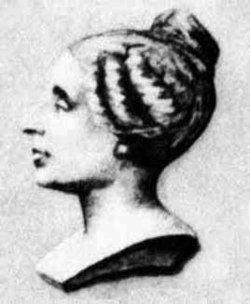Sophie Germain
| Part of a convergent series on Mathematics |
| 1+1=11 |
| We are number one |
Marie-Sophie Germain (1776–1831) was a French mathematician who made a number of important breakthroughs in pure mathematics. If you've never heard of her until now, then there is a pretty strong chance you won't even remotely understand what it was that she did, but we'll do our best to explain. Her work became a critical foundation to an array of major topics in 20th century mathematics, specifically the study of elasticity and data encryption. Her work was also pivotal in the eventual solution of Fermat's last theorem. She somehow managed to do all this while living in 18th century France. There is even a type of number named after her (which is a pretty big deal in mathematicsland.)
Biography[edit]
Germain was born in Paris in 1776, the daughter of either a silk merchant or a goldsmith (there is some dispute on that point).[1] When the French Revolution got underway in 1789 Germain was forced to stay at home, so to amuse herself she spent all her time in the library where she became obsessed with a variety of mathematical texts. After mastering the geometry of Archimedes, she apparently then taught herself Latin and Greek in order to read Newton and Euler.
In 1794 Germain began attending the École Polytechnique. She was not permitted to enroll on account of being female, however she cleverly exploited a loophole which said that lecture notes were to be made available to "anyone who asked". Germain began to send examples of her work to Joseph Louis Lagrange, a member of the faculty and an eminent 18th century mathematician. She used the name M. LeBlanc as she "feared the ridicule attached to a female scientist."[2] Lagrange was deeply impressed by the abilities of M. LeBlanc, hence he requested a meeting, and Germain was forced to disclose her true identity.
After a time Germain began to correspond with Gauss, the absolute heavyweight of mathematics at the time. As with Lagrange, she initially used the Le Blanc pseudonym, and Gauss did not learn her true identity until 1807. On discovering she was female Gauss wrote:
How can I describe my astonishment and admiration on seeing my esteemed correspondent M leBlanc metamorphosed into this celebrated person. . . when a woman, because of her sex, our customs and prejudices, encounters infinitely more obstacles than men in familiarising herself with [number theory's] knotty problems, yet overcomes these fetters and penetrates that which is most hidden, she doubtless has the most noble courage, extraordinary talent, and superior genius.[2]
In 1816 she submitted a paper "Recherches sur la théorie des surfaces élastique" ("Research on the theory of elastic surfaces") to the Paris Academy of Sciences, and consequently became the first woman to ever win the prix extraordinaire. Here's the final equation of her award winning paper:
...which is very much in the category of "if you understand it, you don't need us to explain it, and if you don't, there is no way that we can".
Legacy[edit]
Germain's work would be familiar to any undergraduate student of pure mathematics. Her work on prime numbers was deep and insightful, and any prime number that produces another prime number when you double it and add 1 is called a Sophie Germain prime. An example of a Sophie Germain prime is 5, because 5+5+1 = 11, which is also prime (and is also a Sophie Germain prime: 11+11+1 = 23, yet another one: 23+23+1 = 47). The largest known Sophie Germain prime is 18543637900515 × 2666667−1. It has 200701 decimal digits and was discovered in April 2012. Whether the total number of Sophie Germain primes is infinite is still an open question in mathematics.
Germain has a wider legacy outside of mathematics, as she is an example of "genius being wasted by lack of opportunity". Because Germain was a female in 18th century France, she was largely denied any opportunity to formally study mathematics. So despite her numerous achievements, it is generally accepted that she would have been even greater if she had been properly trained.[3]
References[edit]
- ↑ Gray, Mary W. “Sophie Germain.” Complexities: Women in Mathematics. Ed. Bettye Anne Case and Anne M. Leggett. United Kingdom: Princeton University Press (2005). pp. 68-75.
- ↑ 2.0 2.1 Mackinnon, Nick. Sophie Germain, or, was Gauss a feminist? The Mathematical Gazette 74.469 (1990): 346-351. Web. Sept. 2009
- ↑ Petrovich, Vesna Crnjanski. Women and the Paris Academy of Sciences. Eighteenth-Century Studies 32.3 (1999): 383-391. Web. Sept. 2009.

